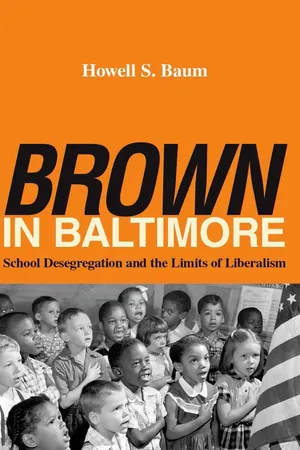
- 296 pages
- English
- PDF
- Available on iOS & Android
About This Book
In the first book to present the history of Baltimore school desegregation, Howell S. Baum shows how good intentions got stuck on what Gunnar Myrdal called the "American Dilemma." Immediately after the 1954 Brown v. Board of Education decision, the city's liberal school board voted to desegregate and adopted a free choice policy that made integration voluntary.
Baltimore's school desegregation proceeded peacefully, without the resistance or violence that occurred elsewhere. However, few whites chose to attend school with blacks, and after a few years of modest desegregation, schools resegregated and became increasingly segregated. The school board never changed its policy. Black leaders had urged the board to adopt free choice and, despite the limited desegregation, continued to support the policy and never sued the board to do anything else.
Baum finds that American liberalism is the key to explaining how this happened. Myrdal observed that many whites believed in equality in the abstract but considered blacks inferior and treated them unequally. School officials were classical liberals who saw the world in terms of individuals, not races. They adopted a desegregation policy that explicitly ignored students' race and asserted that all students were equal in freedom to choose schools, while their policy let whites who disliked blacks avoid integration. School officials' liberal thinking hindered them from understanding or talking about the city's history of racial segregation, continuing barriers to desegregation, and realistic change strategies.
From the classroom to city hall, Baum examines how Baltimore's distinct identity as a border city between North and South shaped local conversations about the national conflict over race and equality. The city's history of wrestling with the legacy of Brown reveals Americans' preferred way of dealing with racial issues: not talking about race. This avoidance, Baum concludes, allows segregation to continue.
Frequently asked questions
Information
Table of contents
- Contents
- Preface and Acknowledgments
- Introduction: Liberalism, Race, and the American Dilemma
- 1. An American Border City
- 2. A Long Black Campaign for Equality
- 3. Opening the Racial Door Slightly
- 4. Desegregation by Free Choice
- 5. Modest Change
- 6. Parents’ Protest against Continuing Segregation
- 7. Growing Integrationism and the Murder of Martin Luther King, Jr.
- 8. Federal Intervention
- 9. Federal Officials, the School Board, and Parents Negotiate
- 10. The City’s Court Victory
- Conclusion: Baltimore School Desegregation, Liberalism, and Race
- Appendix
- Notes
- Index